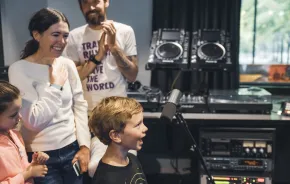
As parents, we’re always thinking about how to build strong kids. We’ve learned that our kids need safety, satisfaction and connection to become resilient. But how often do we think about our needs?
It’s easy to forget that we can’t meet our kids’ needs until ours are met, too. That’s what I thought while reading Rick Hanson’s new book “Resilient: How to Grow an Unshakable Core of Calm, Strength and Happiness.” (It's out March 27.)
I wasn’t surprised to learn while reading that human brains are primed to focus on the negative. It’s so easy for me to marinate in daily difficulties, from the bill I forgot to pay to the recent death of my dog. But, sigh, it’s so hard to parent from that place of negative rumination. Parenting from a place of calm is so much easier.
But how to get there? While reading “Resilient,” I learned the best way to build a calm center was by growing the good in my life. Hanson was happy to chat with me about how parents can, in fact, grow the good and how teach our kids to do it, too. We also talked resilience (psst — he hosts a free online series about the topic.)
Here’s what he had to say.
Why do parents need to build up their resilience before helping their kids do the same?
The model is us. If we build up a calm center for ourselves, we’re showing our kids how to do it.
We need resources out in the world, in the body and in our mind to deal with the challenges of life that wear on our various vulnerabilities. I’m talking about psychological resources like patience, happiness and confidence. That’s how we make our way in the world.
Parents are trying to grow resources in our kids: secure attachment, executive functioning, self-compassion, impulse-control. All these things we are trying to grow in our kids, we need to focus on resources and grow them in our ourselves first.
In effect, as soon as we become parents, we are working to be the person we need to be to parent our kids.
I’ve become enamored with “growing the good.” Can you explain this habit to our readers?
We’ve got brains designed to look for the bad and take it in. Growing the good is a way to hack our brain’s system of focusing on the negative.
When we hardwire happiness by experiencing it, feeling it in our body and noticing what’s rewarding about it, we can be calmer in the face of tribulations. To “grow the good” inside yourself, you’ve got to experience good and marinate in it. Lots of little moments of pleasure calm us down and bring us back to the green zone.
Our brains actually learn to focus on the positive when we make it a habit to focus on moments of pleasure by taking them into ourselves deeply. We can develop a core of well-being that’s harder and harder to shake over time.
A busy mom or a busy dad can actually notice a small pleasure and then take it in for an inhalation or an exhalation or for two or three breathes, just resting in the good. Look at that picture of your daughter and stay with that feeling of admiration for one to 10 breathes. Note the finished task or how it feels to brush your daughter’s hair in the same way.
There are three steps to turn these experiences into lasting change:
- Look for the good.
- Lengthen the feeling by staying with it for five, 10, or 20 seconds.
- Embody it by feeling it in your body.
This gratitude of the moment sounds so dumb until you really need to see small pleasures, and then you realize it actually works.
The amazing fact that “resetting to green” 10 to 20 times a day will calm you down. It’s a simple practice, but it will make you feel that your life is worth living and it will help you feel connected.
You just reset again and again and again.
It’s incredibly hopeful to know that 10 to 20 times a day, we have little opportunities to weave more good threads into the tapestry of our beings. Honestly, happiness matters. Happiness is good medicine.
Plus, happiness is what we want to feel if we wish our kids to be happy. If it’s legitimate to wish it for our kids, it’s legitimate to wish it for ourselves.
How can we model growing the good to our kids?
At least a few times a day, parents can visibly demonstrate what it is like to take in the good. You could simply pause to enjoy a bite of food, to be satisfied that you finished a task or to stay with a sweet moment with your child.
Kids are very observant, and they will pick up on what you are doing. When you realize something about being a more skillful parent, you could explain what you are learning yourself in words that are appropriate to the age of your child; this, too, is a form of taking in the good.
Additionally, you can explicitly encourage children to take in the good themselves. You can do this in the flow of the day, at special occasions such as meals, and just before bed (when the brain is especially receptive).
The fundamental idea is we cannot do anything about the past. But what we can do is help ourselves — and our children — heal and grow and learn as much as possible each day. Taking in the good is the essence of this learning.











